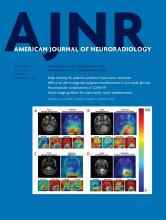As of June 1, 2020, there were 1.84 million confirmed cases of coronavirus disease 2019 (COVID-19) in the United States with more than 372,000 of the cases in New York City. Most of the clinical manifestations of the infection are related to the respiratory and gastrointestinal systems. Several neurologic manifestations of COVID-19 infection have also been documented, predominantly presenting as olfactory or gustatory dysfunction, encephalopathy, and cerebrovascular accidents. We present a less common neurologic symptom presumed to be acute disseminated encephalomyelitis (ADEM), presenting as transverse myelitis in an adult male patient with no preceding upper respiratory symptoms.
The patient is a 44-year-old healthy man who initially presented with urinary retention for 2 days with additional symptoms of bilateral lower extremity weakness and numbness and an inability to walk. There was no history of back trauma, only a history of back pain for which he had taken nonsteroidal anti-inflammatory drugs. There were no upper respiratory symptoms or fever. There was no known recent viral illness or vaccinations.
Initial examination was remarkable only for lethargy, dysarthria, bilateral arm ataxia, urinary retention, and weakness of both legs that was barely antigravity. Initial imaging work-up included a head CT and MR imaging of the lumbar spine. The head CT findings were normal.
The lumbar spine MR imaging demonstrated slight expansion of the conus medullaris with mild T2 hyperintensity and minimal foci of enhancement (Fig 1). The patient was admitted with an impression of transverse myelitis of unclear etiology.
Axial T2 image through the conus demonstrating abnormally increased T2 signal (arrow) with slight expansion of the conus.
Per hospital policy, every admitted patient was tested for Severe Acute Respiratory Syndrome coronavirus 2 (SARS-CoV-2) via a nasopharyngeal swab using a real-time reverse transcription polymerase chain reaction (RT-PCR) test, which resulted positively 1 day after admission.
Further imaging of the remainder of the brain and spinal axis demonstrated nonenhancing T2 hyperintense lesions throughout the cervical and thoracic spinal cord (Fig 2) and several periventricular and juxtacortical lesions within the brain (Fig 3). The inferior cervical lesion demonstrated slight associated cord expansion. There was homogeneous brisk enhancement associated with the dominant left parietal lobe juxtacortical/cortical lesion (Fig 4). A lumbar puncture was eventually performed because of ongoing and progressing symptoms.
Sagittal inversion recovery sequence demonstrating abnormal T2 hyperintense lesions within the lower cervical and upper thoracic spinal cord (arrows).
Axial FLAIR images of the brain demonstrating FLAIR hyperintense lesions (arrows) within the left posterior parietal lobe (A) and periventricular region (B).
Axial T1 postcontrast image demonstrating brisk homogeneous enhancement of the dominant lesion (arrow).
The initial serum tests showed normal complete blood cell count, metabolic panel, urine studies, and inflammatory markers (sedimentation rate, C-reactive protein level) and were negative for HIV. D-dimer was 2.8 μg/mL FEU (reference range, <0.8 μg/mL FEU). Serum cardiolipin antibody immunoglobulin M was mildly elevated at 39 MPL (reference range, 0–12 mpl). Findings of other rheumatologic work-ups were unrevealing. There were no deficiencies in vitamin B12, vitamin E, or copper. Serum protein electrophoresis, angiotensin-converting enzyme levels, and syphilis screen findings were normal.
The CSF profile was largely unremarkable, with white blood cells counts of 6/μL (0–5/μL), of which lymphocytes were 92%; protein 36. CSF bacterial and viral PCR studies were negative. Cytology and flow cytometry were also unrevealing. Oligoclonal bands were absent. The immunoglobulin G (IgG) index was normal. CSF PCR analysis for SARS-CoV-2 was initially questionably positive; however, it was eventually negative to date.
In this patient with unexplained acute encephalopathy and multifocal neurologic signs and symptoms, the constellation of imaging findings in this case is suggestive of ADEM, which may have been triggered by a SARS-CoV-2 infection. The brain lesions are within the periventricular or juxtacortical white matter, predominantly favoring a primary demyelinating process. None of the FLAIR hyperintense lesions in the brain showed hemorrhage as is commonly seen in cases of encephalitis; in addition, the results of the CSF bacterial and viral PCR tests were also negative, making the diagnosis of infectious encephalitis less likely. No T1 hypointense lesions were present. The diagnosis of a first multiple sclerosis attack was thought less likely because of the absence of oligoclonal bands, a normal IgG index, cortical gray matter involvement, and clinical features of encephalopathy.
ADEM is presumed to be a post- or parainfectious process. Typically, ADEM presents in children or adolescents, usually younger than 15 years of age, though cases have been reported in all ages. Approximately 75% of patients have a history of a recent upper respiratory infection or vaccination. Despite reports of the possible association between infection and ADEM, there is no clear understanding of the relationship between the infectious agent and the onset of demyelination. There is experimental evidence in mice for a relationship between coronavirus and CNS demyelination. The literature did report detection of coronavirus in the CNS of a 15-year-old adolescent, and most recently, there has been a report of acute myelitis in an older adult patient with known COVID-19 from Wuhan, China.1⇓-3 The pathophysiology remains uncertain. The patient was initially treated with IV methylprednisolone and subsequently IV immunoglobulin with modest improvement. At the time of this writing, the patient has been discharged to an acute rehabilitation facility.
Footnotes
Disclosures: Gul Moonis—UNRELATED: Royalties: Wolters Kluwer, approximately $150 for Neuroradiology: A Core Review.
Indicates open access to non-subscribers at www.ajnr.org
References
- © 2020 by American Journal of Neuroradiology
















